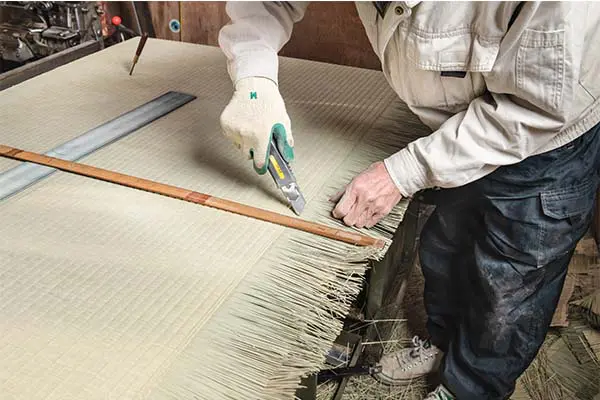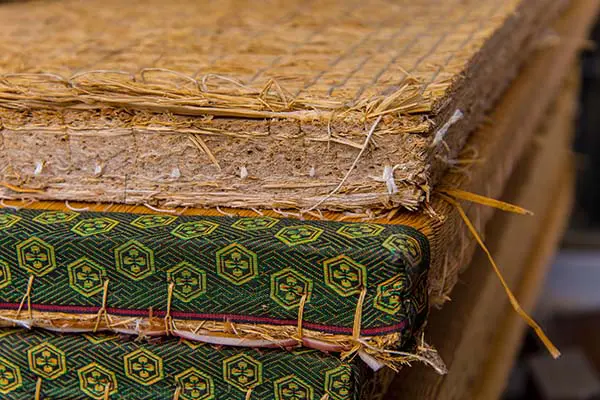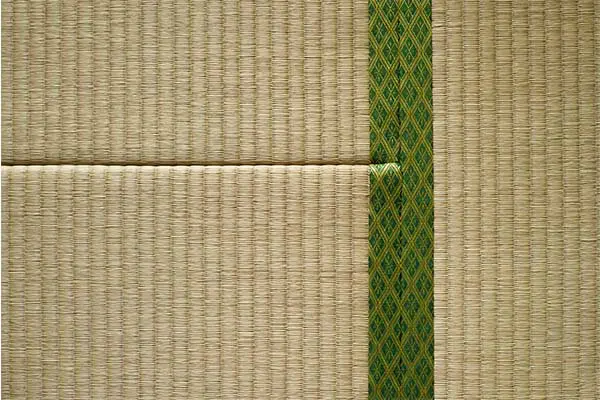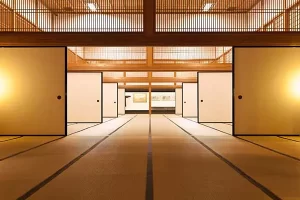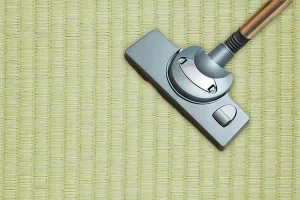How are tatami mats made in Japan?
Contents
About Tatami mat cover "TATAMI OMOTE"
TATAMIOMOTE" is made by weaving rush grass into the warp. Tatami Rush (IGUSA) is ranked according to its quality, length, color, and number.
The high-quality Tatami mat cover "TATAMI OMOTE" is made by selecting high-quality Tatami Rush (IGUSA). The high-quality Tatami mat cover "TATAMI OMOTE" is durable because it is tightly woven with strong threads in the vertical direction. Since long grass is used, the edges of the tatami will not discolor. It is very beautiful with vivid colors.
Vertical thread
There are two types of warp threads: cotton thread and hemp thread, and hemp thread is stronger than cotton thread. In addition, there are combinations of cotton thread only, cotton and linen combination, and hemp thread only, and of course, hemp thread is more durable.
Tatami-omote with strong warp threads allows more Igusa to be woven into the tatami, resulting in a sturdier tatami. In addition, the surface takes the shape of a beautiful mountain, which is aesthetically pleasing. Tatami woven with a lot of igusa also feels good on the skin.
TokyoStore's recommended Tatami
The role of the base of "TATAMIDOKO" that supports the Tatami mat
Do you know what the structure of the Tatami mat is? Specifically, the structure is roughly classified into the following three.
- TATAMIOMOTE (Tatami cover surface)
- TATAMIDOKO (core base material in Tatami)
- TATAMIBERI (Tatami outer frame border part)
Among them, TATAMIDOKO (core base material) plays the role of supporting tatami mats. TATAMIDOKO is the core base material in Tatami, and it is an important part to give cushioning to the Tatami mat itself. A large amount of straw, which is tens of centimeters long, is piled up in layers, compressed to about 5 cm, and sewn up.
Standard Tatami mats are said to have a typical lifespan of 10 to 20 years. In addition, it can be used for a long period of about 40 years if it is properly maintained.
Rice straw is mainly used as the base material, but there are various other types such as straw sand floors and building material floors. However, due to the scarcity of straw and housing conditions, building material floors are now in widespread use.
The building material floor is a tatami floor (base material) that uses styrofoam and insulation boards (shreds of wood) and does not use a straw at all. It is heavier than the straw TATAMIDOKO, but instead has better durability and moisture resistance. Functions such as heat insulation and moisturizing properties differ depending on the material used.
TokyoStore's recommended Tatami
Tatami outer frame border part that influences the design
All standard Tatami mats look the same. However, if you look closely at the cloth fabric part (TATAMIBERI) of the Tatami outer frame border, the design will often be different. The outer frame border part of the Tatami mat is called TATAMIBERI and is sewn to make the edges look beautiful. It also protects the Tatami mat by preventing friction on the corners of the Tatami mat.
Recently, Tatami mats without an outer frame have been talked about, but they are more expensive than those with TATAMIBERI. Silk thread and linen thread are generally used as the material of TATAMIBERI.Nowadays, those woven with chemical fibers have become the mainstream, and the colors are also abundant.
When you look at a standard Tatami mat, pay attention to TATAMIBERI for the border part of the outer frame of the Tatami mat.
Today, various types of mats, rugs, and carpets made of Tatami Rush are on sale.Thick traditional tatami mats, lightweight tatami mats, tatami rug carpets, and various designs. Enjoy traditional Japanese design, modern Japanese design, and your favorite type.
Recommended Products
Author Profile
Latest entries
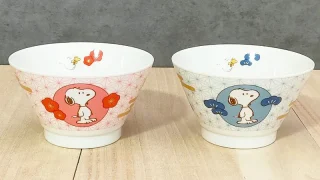 Rice Bowl / Ramen Bowl2025年8月5日Snoopy Japanese Rice Bowl Set - Red Plum & Blue Pine Design - Made in Japan, Microwave & Dishwasher Safe
Rice Bowl / Ramen Bowl2025年8月5日Snoopy Japanese Rice Bowl Set - Red Plum & Blue Pine Design - Made in Japan, Microwave & Dishwasher Safe matcha bowl / Yunomi tea cup2025年1月21日Kutani ware teacups are very easy to use
matcha bowl / Yunomi tea cup2025年1月21日Kutani ware teacups are very easy to use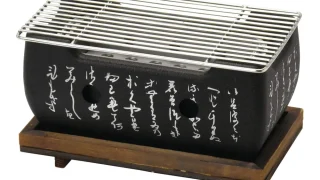 Japanese style BBQ stove grill2025年1月20日Combine a Japanese style BBQ stove grill and sake cups for a special dinner
Japanese style BBQ stove grill2025年1月20日Combine a Japanese style BBQ stove grill and sake cups for a special dinner SAKE bottle and SAKE cup2025年1月17日Mino Ware Gold-painted Sake Ware is Very Beautiful
SAKE bottle and SAKE cup2025年1月17日Mino Ware Gold-painted Sake Ware is Very Beautiful

